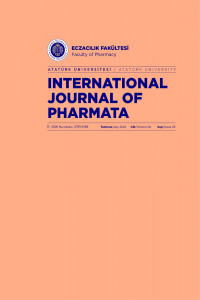Abstract
Beyond energy storage, adipose tissue is an active endocrine organ in which adipocytokines are secreted, which have specific effects on various biological processes such as metabolic homeostasis, immunity, inflammation. However, excess energy accumulated in the body changes the size, distribution and cellular composition of adipose tissue, causing deterioration in its structural and functional functions. 2 In this situation, beneficial adipocytokines are down-regulated, while leptin and other proinflammatory adipokines are highly up-regulated. Visfatin, also known as nicotinamide phosphoribosyl transferase (Nampt), is a proinflammatory cytokine intensely expressed in adipose tissue. Accumulating evidence focuses on the potential role of visfatin in the pathogenesis of metabolic diseases and related complications, suggesting that it may be a promising molecule. However, the contradictory results of the studies show that our understanding of visfatin is still speculative, but its secretion mechanism and physiological role are not fully understood. In this review, the role of this promising molecule in metabolic diseases is explained by presenting comprehensive information about visfatin/Nampt.
Keywords
References
- 1.MARTÍNEZ LARRAD, María Teresa, et al. Obesity and cardiovascular risk: Variations in visfatin gene can modify the obesity associated cardiovascular risk. Results from the Segovia population based-study. Spain. PloS one, 2016, 11.5: e0153976.
- 2.FASSHAUER, Mathias; BLÜHER, Matthias. Adipokines in health and disease. Trends in pharmacological sciences, 2015, 36.7: 461-470.
- 3.FUKUHARA, Atsunori, et al. Visfatin: a protein secreted by visceral fat that mimics the effects of insulin. Science, 2005, 307.5708: 426-430.
- 4.SABOORI, S., et al. The comparison of serum vaspin and visfatin concentrations in obese and normal weight women. Diabetes & Metabolic Syndrome: Clinical Research & Reviews, 2015, 9.4: 320-323.
- 5.FARSHCHIAN, Fatemeh, et al. Visfatin and resistin serum levels in normal-weight and obese women with polycystic ovary syndrome. International journal of endocrinology and metabolism, 2014, 12.3.
- 6.BERNDT, Janin, et al. Plasma visfatin concentrations and fat depot–specific mRNA expression in humans. Diabetes, 2005, 54.10: 2911-2916.
- 7.JIN, Hua, et al. Serum visfatin concentrations in obese adolescents and its correlation with age and high-density lipoprotein cholesterol. Diabetes research and clinical practice, 2008, 79.3: 412-418.
- 8.JEBUR, Iman M., et al. Serum magnesium and visfatin levels in newly diagnosed non-obese type 2 diabetes without insulin resistance: a cross-sectional study. Clinical Diabetology, 2021, 10.1: 123-128.
- 9.ZHENG, Long-Yi, et al. Association between serum visfatin levels and atherosclerotic plaque in patients with type 2 diabetes. Diabetology & metabolic syndrome, 2019, 11.1: 1-7.
- 10.PANIDIS, Dimitrios, et al. Plasma visfatin levels in normal weight women with polycystic ovary syndrome. European journal of internal medicine, 2008, 19.6: 406-412.
- 11.OZKAYA, Mesut, et al. Effect of metformin on serum visfatin levels in patients with polycystic ovary syndrome. Fertility and sterility, 2010, 93.3: 880-884.
- 12.GÜDÜCÜ, Nilgün, et al. Serum visfatin levels in women with polycystic ovary syndrome. Gynecological Endocrinology, 2012, 28.8: 619-623.
Abstract
References
- 1.MARTÍNEZ LARRAD, María Teresa, et al. Obesity and cardiovascular risk: Variations in visfatin gene can modify the obesity associated cardiovascular risk. Results from the Segovia population based-study. Spain. PloS one, 2016, 11.5: e0153976.
- 2.FASSHAUER, Mathias; BLÜHER, Matthias. Adipokines in health and disease. Trends in pharmacological sciences, 2015, 36.7: 461-470.
- 3.FUKUHARA, Atsunori, et al. Visfatin: a protein secreted by visceral fat that mimics the effects of insulin. Science, 2005, 307.5708: 426-430.
- 4.SABOORI, S., et al. The comparison of serum vaspin and visfatin concentrations in obese and normal weight women. Diabetes & Metabolic Syndrome: Clinical Research & Reviews, 2015, 9.4: 320-323.
- 5.FARSHCHIAN, Fatemeh, et al. Visfatin and resistin serum levels in normal-weight and obese women with polycystic ovary syndrome. International journal of endocrinology and metabolism, 2014, 12.3.
- 6.BERNDT, Janin, et al. Plasma visfatin concentrations and fat depot–specific mRNA expression in humans. Diabetes, 2005, 54.10: 2911-2916.
- 7.JIN, Hua, et al. Serum visfatin concentrations in obese adolescents and its correlation with age and high-density lipoprotein cholesterol. Diabetes research and clinical practice, 2008, 79.3: 412-418.
- 8.JEBUR, Iman M., et al. Serum magnesium and visfatin levels in newly diagnosed non-obese type 2 diabetes without insulin resistance: a cross-sectional study. Clinical Diabetology, 2021, 10.1: 123-128.
- 9.ZHENG, Long-Yi, et al. Association between serum visfatin levels and atherosclerotic plaque in patients with type 2 diabetes. Diabetology & metabolic syndrome, 2019, 11.1: 1-7.
- 10.PANIDIS, Dimitrios, et al. Plasma visfatin levels in normal weight women with polycystic ovary syndrome. European journal of internal medicine, 2008, 19.6: 406-412.
- 11.OZKAYA, Mesut, et al. Effect of metformin on serum visfatin levels in patients with polycystic ovary syndrome. Fertility and sterility, 2010, 93.3: 880-884.
- 12.GÜDÜCÜ, Nilgün, et al. Serum visfatin levels in women with polycystic ovary syndrome. Gynecological Endocrinology, 2012, 28.8: 619-623.
Details
| Primary Language | English |
|---|---|
| Subjects | Pharmacology and Pharmaceutical Sciences |
| Journal Section | Reviews |
| Authors | |
| Publication Date | July 6, 2022 |
| Published in Issue | Year 2022 Volume: 2 Issue: 3 |


